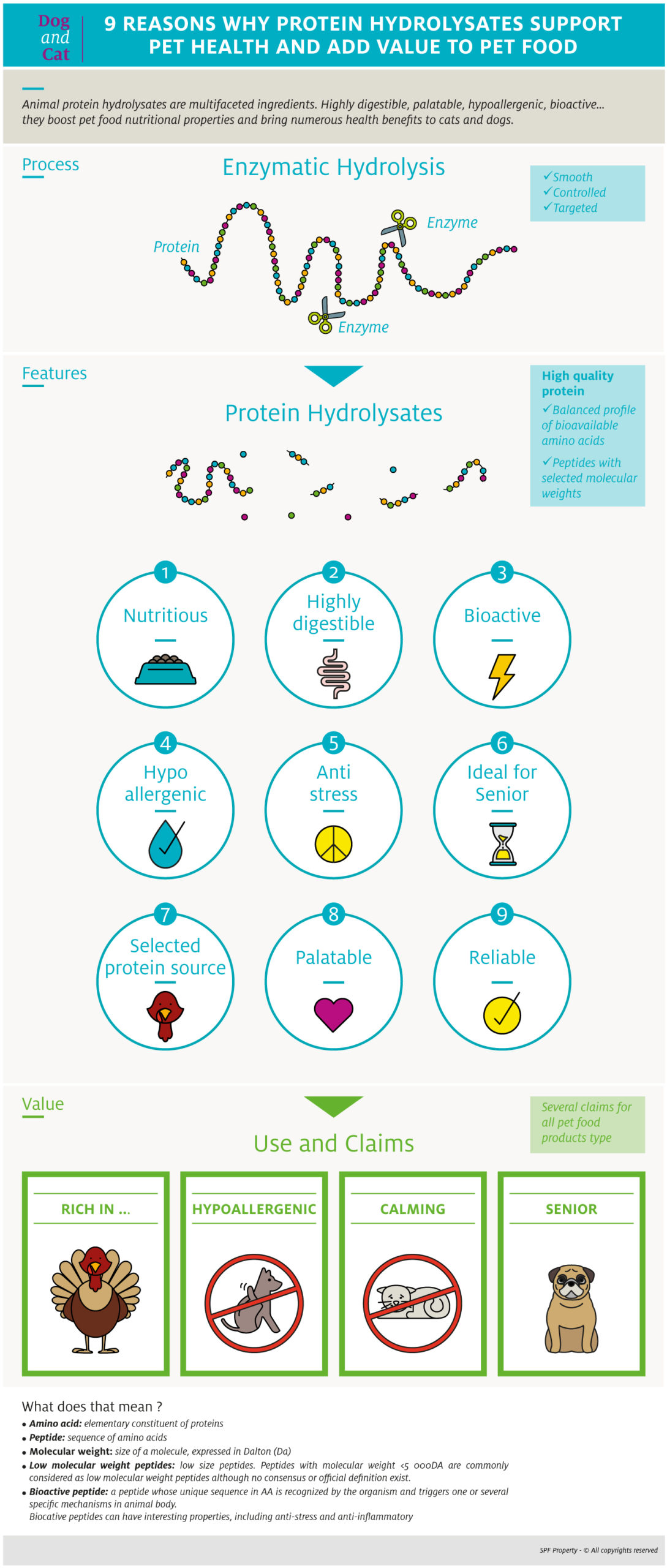Let’s play!
Imagine you are a marketing manager at a pet food company.
Your mission: please pet parents with products that improve pet health and well-being.
And now, imagine you are a pet food nutritionist in this same company.
Your mission: design a product that meets basic pet nutritional needs and brings proven and reliable health benefits.
Your strategy: focus on proteins. You know they are essential to pet nutrition and who knows, they might bring more benefits as well.
And here begins the game: what will you choose among the plethora of raw materials and ingredients?
Lucky you! You draw a chance card… And here they are protein hydrolysates!
Discover 9 reasons why these versatile ingredients can help you design healthy food for cats and dogs.
1. Hydrolysates are high-quality and nutritious protein sources
It’s not a secret. Proteins are essential to pet nutrition!
Indeed, they are the principal constituents of body organs and tissues and they play key roles in several body mechanisms.
Proteins must thus be supplied in adapted amount via the food to ensure smooth functioning of the organism.
Main sources of animal protein used in pet food are meals obtained from meat or fish by-products. These raw materials are often rich in protein. However, their manufacturing process including long cooking time at high temperatures can decrease protein nutritional values such as digestibility.
Enzymatic protein hydrolysates of animal origin are interesting alternatives because they bring protein with superior quality. They are obtained by combining a soft cooking process with specific enzymes to cut the protein of meat or fish-based raw materials into free amino acids and low molecular weight peptides.
Amino acid profiles are key for pet nutrition. Indeed, some amino acids, essential to cats and dogs, cannot be synthesized by the animal and must be obtained from the food in sufficient quantities.
The first step, then, to design quality hydrolysates is to select raw materials that contain these essential amino acids.
The process applied must then preserve the nutritional value of these amino acids.
Contrary to meal process or chemical hydrolysis, the enzymatic hydrolysis is smooth, controlled and preserves amino acid bioavailability.
The ideal tool for nutritionists, animal enzymatic hydrolysates are high-quality protein sources. Their amino acid and peptide profiles can be selected to reach optimal nutritional value for cats and dogs.
2. Hydrolysates are highly digestible
During digestion in pets, food components are broken into nutrients. These are the basic elements that are absorbed and used by the organism to ensure various body functions.
Peptides and free amino acids are the nutrients obtained from the natural digestion of proteins.
By cutting protein into low molecular weight peptides and free amino acids, enzymatic hydrolysis acts like a pre-digestion, mimicking what happens in the digestive system of the animals.
Quality protein hydrolysates are thus easier to assimilate than other protein sources where protein is intact.
That’s the reason why a good hydrolysate generally has higher digestibility than meal, although both can be made from same fresh raw materials.
3. Hydrolysates are bioactive
Controlled enzymatic hydrolysis process generates low molecular weight peptides.
And one major interest of low size peptides is that beyond their nutritional value, some of them have special properties that might enhance health.
Made of 2 to 20 amino acids, each bioactive peptide has a unique structure that is recognized by the body and triggers various regulatory mechanisms. Obtained from raw materials of different origin, some of them are antioxidant; others have anti-inflammatory properties; and still others can forestall hypertension.
Important point: it has been demonstrated that it is the combination of several bioactive peptides in a hydrolysate that leads to the best performance. Each protein hydrolysate has a single peptide profile that corresponds to specific health benefits.
One change in the hydrolysate peptide profile and the benefits disappear!
The challenge is to select the right raw materials, the right enzyme and the right hydrolysis parameters to be sure that the hydrolysate contains the targeted bioactive peptide profile.
4. Hydrolysates are hypoallergenic
A cat is scratching? Bet it comes from food!
Indeed, this unpleasant sensation that provokes pets’ uncontrollable desire to scratch is often linked to food allergies.
Normally, the bodies of cats and dogs accept the food they eat. But sometimes the body develops adverse reactions toward specific foods. These foods can provoke reactions ranging from simple intolerance when food is not digested to true food allergy, in which the food triggers strong reactions involving the immune system.
Among food components, proteins are the main cause of allergenic responses.
When a dietary protein is considered undesirable by the immune system, several reactions occur, with manifestations such as scratching, skin lesions and diarrhea.
If this same allergenic protein is sufficiently hydrolyzed before being included in the food, the body won’t recognize it, allergenic mechanisms will not be triggered, and the cat will stop scratching!
But be careful. Not all hydrolysates are equal when it comes to limiting unpleasant reactions to food.
To have hypoallergenic properties, protein hydrolysates must contain the maximum amount of low size peptides. This requires perfect management of the hydrolysis process as well as precise measurement of peptide size and characterization of the peptide profile.
Tests conducted in vitro or with pets are also essential to validate the real hypoallergenicity of hydrolysates. They allow the sustaining claim that pet food manufacturers can use to promote the health benefits and value of their products.
5. Hydrolysates can reduce pet stress
In cats and dogs as in humans, the mechanisms of stress are complex.
When an animal perceives a threat, whether real or imagined, a chain of reactions is activated, ultimately provoking the release of stress hormones in the body.
While occasional stress is considered normal, chronic stress can negatively affect a pet’s health.
Some bioactive peptides generated in enzymatic hydrolysates of fish origin have proven to lower canine stress intensity by limiting release of stress hormones.
Use of hydrolysates with proven anti-stress peptides is particularly indicated to anticipate stressful situations such as holidays, separations or introduction of new pets at home.
It facilitates adaptation to stressful situations and contributes to a pet’s improved quality of life.
6. Hydrolysates can boost nutrition for senior pets
Cats and dogs are no exception to the rule: like humans, they do not escape the signs of aging.
As time goes by, a pet’s body may show different signs of weakness. One such is that the digestive system is less efficient in senior pets.
Moreover, aging is often accompanied by loss of appetite and a decrease in food consumption.
This may lead to insufficient protein supply ultimately resulting in a loss of muscle mass that will weaken the pet.
Foods for senior cats and dogs must thus be formulated to compensate for lower protein intake and assimilation.
Protein hydrolysates obtained via enzymatic hydrolysis are highly digestible. Moreover, their amino acid and peptide profiles can be selected to fit the particular nutritional requirements of senior animals.
Protein hydrolysates are ideal to boost the nutritional value of senior pet food and ensure healthy aging of pets.
7. Hydrolysates are selected protein source ideal for species claims
Hydrolysates from chicken by-products are the most common on the market.
But those who master the hydrolysis process can create hydrolysates from many other raw materials, including turkey, beef, lamb, fish or even kangaroo.
Pet food manufacturers can use these high-quality meat protein sources in their formulas at dosages enabling them to add claims such as “Rich in poultry” or “Only beef” on their packaging.
Beyond enabling species claim in traditional pet foods, these standardized single-source proteins can also fit hypoallergenic diets that use “exotic” proteins, not commonly found in pet food, as a preventive strategy to avoid adverse food reactions.
8. Hydrolysates are palatable…
… or at least, they do not decrease palatability !
It is well known that amino acids and peptides play a key role in pet food flavor. Indeed, many of these low size compounds can enhance cat and dog food palatability and stimulate an animal’s desire to eat.
However, some amino acids and peptides can bring unwanted tastes such as bitterness, which could decrease palatability and thus food consumption.
Hydrolyzed protein, rich in peptides and free amino acids, can thus be more palatable than traditional raw materials, providing they have the good amino acid and peptide profiles.
Once again, it is the mastery of the process that will allow developing hydrolysates with targeted compounds that do not affect pet food palatability.
9. Hydrolysates are reliable
You get the point: enzymatic protein hydrolysates have multiple valuable functions. And the icing on the kibbles? These powerful ingredients are also highly trustworthy.
As explained, enzymatic hydrolysis is a challenging but powerful process. If well mastered, it allows manufacturers to produce ingredients with consistent quality and composition.
By mastering raw material freshness and composition, enzyme selection, hydrolysis process parameters such as cooking time and temperature, and final product profile characterization, experts in hydrolysis can deliver a product with the same amino acids and peptides, batch after batch.
Pet food formulators and purchasers can rest easy; the product they receive today is the same as it was yesterday and will be tomorrow!
GLOSSARY
- Amino acid: elementary constituent of proteins
- Peptide: sequence of amino acids
- Molecular weight: size of a molecule, expressed in Dalton (Da)
- Low molecular weight peptides: low size peptides. Peptides with molecular weight <5 000Da are commonly considered as low molecular weight peptides although no consensus or official definition exist.
- Bioactive peptide: a peptide whose unique sequence in AA is recognized by the organism and triggers one or several specific mechanisms in animal body.
Bioactive peptides can have interesting properties, including anti-stress and anti- inflammatory.
Take-home points
![[Infographic] – 9 reasons why protein hydrolysates support pet health and add value to pet food](https://www.appetizerblog.com/wp-content/uploads/2021/01/dpf_blog_infographics_9_reasons_why_protein_hydrolysates_header-1250x545.jpg)




* required fields